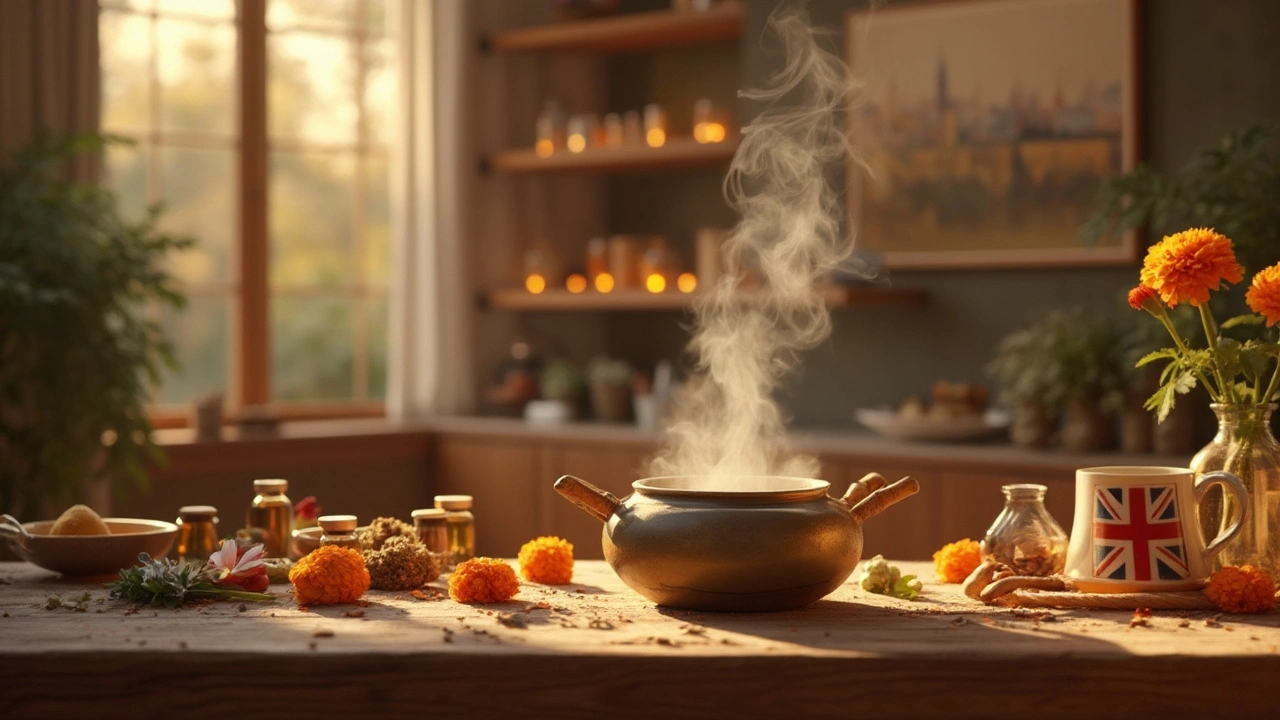Ever walk out of a massage thinking, “Is that all there is?” Ayurvedic massage isn’t your regular deep-tissue appointment. It’s got roots going back thousands of years in India, and there's a reason health spas keep hyping it up. The techniques are different, the focus is wider, and the results can stick with you longer—if you get what’s really going on.
Here’s the truth: Ayurvedic massage is about balancing your whole system, not just loosening up knots. The therapist actually tailors your session using herbal oils and massage strokes based on your body type (they call it “dosha”). If you’re hoping for something more than just a quick fix for a stiff back, you’re in the right place.
Ready to find out why Ayurveda believers swear by it? Let’s get into what makes this ancient approach still matter today.
- What is Ayurvedic Massage, Really?
- Popular Types and Techniques
- The Role of Oils and Personalization
- Making the Most of Your Session
What is Ayurvedic Massage, Really?
When people talk about Ayurvedic massage, they’re talking about something way bigger than your typical rubdown. Ayurveda is an old-school health system from India that focuses on the whole body, not just fixing what hurts. The whole idea is to keep your mind and body in sync, which makes this massage different from anything you’ve tried before.
Here’s what makes it truly stand out: it’s not a one-size-fits-all gig. The therapist tweaks everything—the strokes, the oils, and even the pressure—based on your body’s makeup. In Ayurvedic terms, they call your type a ‘dosha.’ Plenty of people don’t realize that has a ton of influence over how you react to things like stress, diet, and—yep—even massage.
Ayurvedic massage uses warm oils, and these aren’t random oils off a shelf. They’re packed with herbs chosen for what you need that day. The massage itself isn’t just about relaxing your muscles; it’s also about helping your body flush out stuff it doesn’t need (hello, toxins) and jumpstarting your natural healing.
"Ayurveda approaches massage as a tool to restore individual balance, not just for relaxation or pain relief. The right touch and oils make all the difference," says Dr. Vasant Lad, founder of the Ayurvedic Institute.
Here’s a quick snapshot to show just how central Ayurveda is to Indian wellness culture:
| Ayurvedic Massage Fact | Details |
|---|---|
| Origin | Ancient India, over 3,000 years ago |
| Main goal | Balance physical, mental, and emotional health |
| Method | Customized oils & massage for each body type |
| Typical session length | 60 to 90 minutes |
So if you’re picturing soft background music and a cookie-cutter routine, scratch that. Instead, imagine a session that’s built for you. That’s the real deal with Ayurvedic massage—crafted so you walk out feeling totally different, maybe even lighter, and definitely more in tune with yourself.
Popular Types and Techniques
If you think all Ayurvedic massage is the same, get ready for a surprise. There are real differences in how each type works—and it’s not just about what feels good, but what your body actually needs. The goal is to balance and support you as a whole, not just rub away tension.
The most talked-about style is Abhyanga. This one’s a full-body massage using plenty of warm, herbal oil. Therapists use long, flowing strokes and focus on the joints, muscles, and even your scalp. The point isn’t just relaxation—it’s about helping your body detox and get your energy moving smoothly. Honestly, it’s a game-changer for stress and sleep.
Another common approach is Shirodhara, which looks strange but feels amazing. Here, warm oil is poured in a steady stream over your forehead for up to 40 minutes. It’s meant to calm the mind, help with insomnia, and some folks swear it helps with migraines. You stay lying down and just let the sensation take over. Don’t expect a full-body rub with this—it’s all about mental reset.
Pada Abhyanga is all about the feet and lower legs, which might sound boring but is great if you’re on your feet all day or deal with swelling. Therapists use pressure points (marma points) to boost circulation and relax your whole system. Neck and back tension? Try Pizhichil—where warm oil is squeezed onto your body while you’re massaged at the same time. It’s more of a luxury treatment, but fans say it’s amazing for aches and deep tiredness.
To keep it simple, here’s how an average session might go:
- You identify your dosha (body type) before you start—Vata, Pitta, or Kapha.
- The therapist chooses oils and pressure based on your needs.
- You get a head-to-toe routine if it’s Abhyanga, or a targeted approach for something like Shirodhara or Pada Abhyanga.
- The strokes are tailored—not random. For Vata, more grounding and warm; for Pitta, cooler and calming; for Kapha, stimulating and energizing.
Trying different types can help you figure out what really clicks with you. Don’t be afraid to ask questions or talk about how you’re feeling during the process. No two sessions are exactly the same, and that’s kind of the point.

The Role of Oils and Personalization
If you've ever tried an Ayurvedic massage, you know oils are a big deal—way more than just a slippery bonus. The therapist doesn't just pick any old oil. Oils are picked for your personal needs, just like you'd choose your favorite sports drink based on flavor and what your body craves after a workout. The main goal? Support your unique dosha, or body type, and target whatever issues bug you most, whether it’s stress, aches, or dry skin.
There are three main Ayurvedic body types: Vata (airy and cold), Pitta (hot and sharp), and Kapha (heavy and smooth). Each type gets their own tailored oil blend. For example, dry-skinned, anxious Vata types do well with warming, grounding oils like sesame. If you run hot and get easily irritated (hello, Pitta), coconut or sunflower oil helps cool things down. Heavier Kapha types benefit from invigorating oils like mustard or even a bit of warming eucalyptus. Personalization matters because your experience can totally change depending on what oil's being rubbed in and how.
Some clinics even infuse oils with herbs—think neem for skin problems, or ashwagandha if you need a boost. There’s legit science here: According to a study published in the Journal of Ayurveda and Integrative Medicine, certain herbal oils used in Ayurvedic massage can reduce muscle pain and boost circulation better than basic oil blends.
"Individualized herbal oils allow the massage to target not only physical but also emotional imbalances unique to every person," says Dr. B.V. Raghavendra, senior ayurvedic practitioner at Bangalore Ayurveda Centre.
- Always ask what oil will be used and why—it’s not just a ‘one size fits all’ thing.
- Request a patch test if you’ve got sensitive skin or allergies. These oils can be potent.
- Ask for details about any infused herbs, especially if you’re pregnant or taking medications.
Check out how some popular oils stack up in different uses:
| Oil Type | Best For | Main Benefit |
|---|---|---|
| Sesame | Vata, sore joints | Warming, deep moisturizing |
| Coconut | Pitta, overheated skin | Cooling, soothes irritation |
| Mustard/Eucalyptus | Kapha, sluggish muscles | Invigorating, boosts blood flow |
So next time you’re booking a session, don’t just go with whatever’s on offer. Ask questions, get specific, and make the oil actually work for you. Your body (and your skin) will thank you.
Making the Most of Your Session
Nobody wants to spend an hour on a massage table and leave feeling like they didn’t get their money’s worth. Getting the best out of an Ayurvedic massage is easier when you know what to expect and how to prep for it. Here’s how to actually make that time count.
- Talk to your therapist: Before the session, tell them if you’ve got injuries, chronic pain, or specific areas that need attention. That info can change which oils or strokes they use.
- Know your dosha: If this is your first ride, ask for a quick dosha check (usually a verbal Q&A). Therapists often tailor the experience based on whether you’re more Vata, Pitta, or Kapha.
- Skip heavy meals: Don’t show up right after a burger or pizza session at home. Ayurveda says digestion slows during massage, and a full stomach makes everything less comfy.
- Go tech-free: Turn off your phone. No notifications, no distractions. This sort of massage isn’t just physical—it’s supposed to calm your mind, too.
Keep in mind, the oils used in Ayurveda are a big deal. A study published in the Journal of Traditional and Complementary Medicine (2021) found clients reported higher relaxation and better sleep after just 3 weekly Ayurvedic massages compared to regular oil massages.
Take a look at a quick breakdown of post-massage benefits based on survey data from major Ayurvedic clinics in Mumbai and southern India:
| Benefit | % of People Reporting |
|---|---|
| Reduced stress | 85% |
| Improved sleep | 73% |
| Less muscle pain | 65% |
| Better energy next day | 58% |
After your session, don’t race back to a hectic schedule. Try to relax at least 30 minutes. Let those herbal oils linger on your skin if you can, and drink warm water to help detox. If you feel “off” afterward (lightheaded, a bit emotional), that’s normal—Ayurvedic massage can release pent-up stuff physically and mentally. You’ll often notice the real difference the next day.
Last thing: if you find a therapist who clicks with you and gets your body’s quirks, stick with them. The more they know you, the better they can personalize each session. Think of it like a regular check-in for your health, not a one-off treat.






